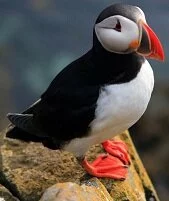Wildlife

Reindeer
Due to the numerous ecological zones created by the vast differences in geography, the changing latitude, and the weather, there are thousands of animals that call Norway home. This includes numerous animals both on shore as well as just off the coast in the surrounding waters.
Norway is home to numerous mammals, both large and small. On land, many of the most common animals are also mammals including reindeer (known as caribou in North America), moose (or elk), otters, foxes, beavers, mink (although today most of the mink are American mink), red squirrels, and wolverines. The polar beer and brown bear can also be found in the country as can the musk ox, a more recent import. Off the coasts there are numerous other mammals, most commonly some species of whales.
Other animals found in the surrounding seas include thousands of fish, birds, and other sea life. The sea life isn't limited to the oceans though. In addition to the salt water fish in the oceans, there are numerous fresh water fish in the country's lakes and rivers. Although the fresh water fish species are limited, the salt water fish dominate the coasts as herring, lobster, and salmon are all common, as are dozens of others.

Puffin
Birds are less common in Norway due to their climate, but there are a number of seasonal migrating birds along with some game birds. Perhaps the most famous of these birds is the puffin, but many other birds call the country home, including the white-throated dipper, buzzards, swans, smews, ravens, and grouse, among others.
There are very few amphibians and reptiles in Norway, but they do exist. A couple snakes are perhaps the most common, although even they are rare.
When it comes to plant like, Norway is somewhat limited in scope. Due to the northern climate and the poor soils there is a limited number of plants in Norway. In fact nearly a third of the country is above the tree line so in these areas the plant life is limited to shrubs, flowers, and other small plants. Trees, including birch trees, pine trees, aspens, willows, and numerous others are common in Norway. Grasses and small flowers can also be commonly found. Fruits and vegetables are uncommon; although many root vegetables have been introduced and are popular, including the potato.